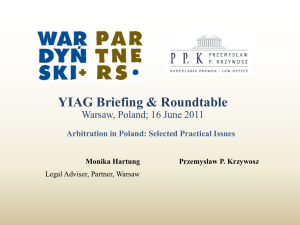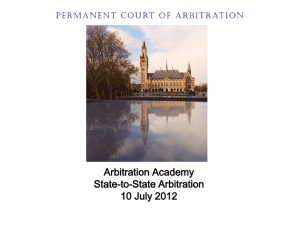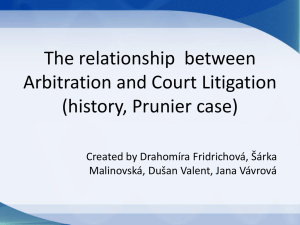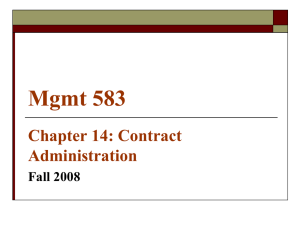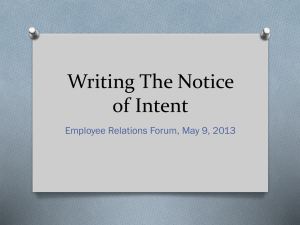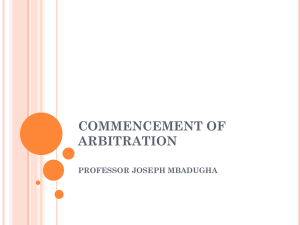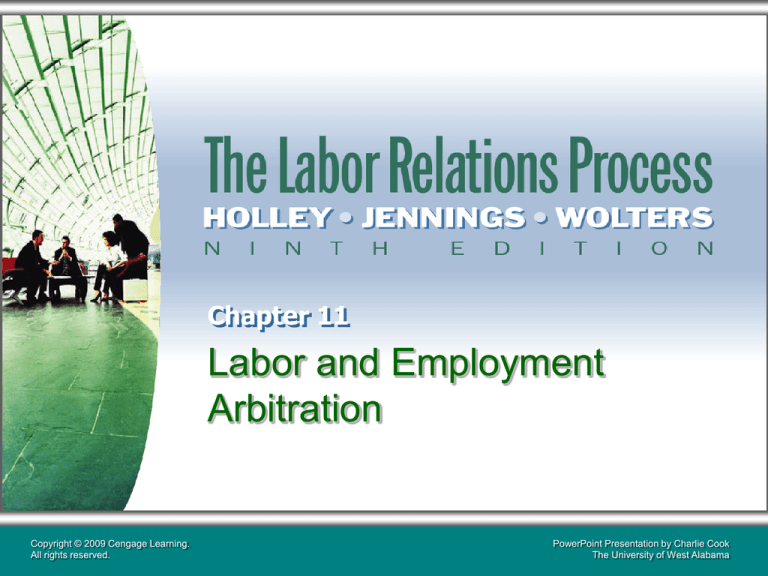
Chapter 11
Labor and Employment
Arbitration
Copyright © 2009 Cengage Learning.
All rights reserved.
PowerPoint Presentation by Charlie Cook
The University of West Alabama
Development of Labor Arbitration
• 1865 to World War II
Arbitration was first used in 1865.
Executive Order 9017 established National War Labor
Board (NWLB), which used arbitration to avoid strikes
in war materials production plants during WWII.
Arbitrator’s decisions could be ignored at will.
• The Postwar Years
Lincoln Mills case (1957)
An aggrieved party could sue a party that refused to arbitrate
a labor dispute for violation of the labor agreement under
Section 301 of the LMRA.
© 2008 Cengage Learning. All rights reserved.
11–2
Development of Labor Arbitration (cont’d)
• The Steelworkers’ Trilogy Decisions
Arbitrators, not courts, decide whether the grievance
is arbitrable.
The courts recognize arbitrators’ knowledge of the
common law of the shop in deferring to arbitration.
Arbitrators have no obligation to the court to give their
reasons for an award.
Courts only decide if grievance should be submitted
to arbitration when there is disputed language in the
labor contract.
© 2008 Cengage Learning. All rights reserved.
11–3
Legal Obligations to Arbitrate and Enforce
Arbitration Decisions
• Continuing Rights Under a Labor Contract
Successor employers can be required to arbitrate a
preexisting grievance.
Grievances arising prior to the termination of a labor
agreement can be arbitrated.
• Boys Market Decision
Parties to a labor contract must use the contractually
specified arbitration procedure.
© 2008 Cengage Learning. All rights reserved.
11–4
Selection of an Arbitrator
• Securing listings of arbitrators
Federal Mediation and Conciliation Service (FMCS)
American Arbitration Association (AAA)
State and local agencies
• Selection procedures
Striking method: eliminating names from a list until
one arbitrator’s name remains.
Striking and ranking: eliminating names from a list
and selecting the highest-ranked remaining name.
Requesting a direct appointment.
© 2008 Cengage Learning. All rights reserved.
11–5
Types of Arbitrators
• Permanent Arbitrator or Umpire
An arbitrator who will resolve all disputes during the
life of a labor agreement.
Permanent status allows the arbitrator to become
intimately knowledgeable about the industry, the
company, and the union.
• Ad Hoc Arbitrator
The arbitrator is selected on a case-by-case basis,
providing flexibility in the use of different arbitrators in
addressing specific grievance issues.
© 2008 Cengage Learning. All rights reserved.
11–6
Exhibit 11.1 Profile of Members of the National Academy of Arbitration and
Arbitration Data (462 responses from 600 members)
SOURCE: Michel Picher,Ronald Seeber, and David B. Lipsky, The Arbitration
Profession in Transition, Ithaca, NY: Cornell/PERC Institute of Conflict Resolution,
2000, pp. 11–28; updated from http://www.fmcs.gov (accessed January 9, 2004).
© 2008 Cengage Learning. All rights reserved.
11–7
Arbitration Procedures
• Prehearing Activities
Prehearing Stipulations
Joint union-management statements as to the issues involved
and certain applicable grievance “facts”
• The Arbitration Hearing
Averages one day in length
Formats:
Informal quasi-litigation (legalistic approach)
Formal, ongoing collective bargaining (problem-solving
approach)
© 2008 Cengage Learning. All rights reserved.
11–8
Exhibit 11.2 Behavioral Examples of Legalistic Versus
Problem-Solving Approaches
Legalistic Approach
Problem-Solving Approach
Drafting the statement of the issue in such a
way that there is a definite winner and a definite
loser.
Looking for restrictions on the arbitrator’s
authority to hear issues not expressly stated in
the written grievance.
Insisting on a specific burden of proof at the
beginning of the hearing (preponderance of
evidence, clear and convincing evidence, or
beyond a reasonable doubt).
Harsh and aggressive (eat ’em alive) crossexamining in an attempt to destroy witness
credibility.
Objecting to any form of hearsay evidence.
Noting for the record objections to certain types
of evidence, even though the arbitrator has
allowed the evidence to be introduced.
Acknowledging that the parties have a mutual
obligation to bring out all relevant facts.
Citing custom and/or practice of the parties.
Arguing that the arbitrator should interpret
provisions of the collective bargaining
agreement in such a way that it will be
reasonable and equitable to both parties.
Stipulating certain facts where the parties have
no dispute.
Asking questions that call for a narrative
answer, for example, asking the witness to tell
the story about what happened in her own
words.
Asking only a few nonthreatening questions on
cross-examination.
Using friendly and dignified behavior toward the
opposite party.
SOURCE: Adapted from Richard A. Posthuma and Maris Stella Swift, ‘‘Legalistic vs. Facilitative Approaches
to Arbitration: Strengths and Weaknesses,’’ Labor Law Journal, 52 (Fall 2001), pp. 181–182.
© 2008 Cengage Learning. All rights reserved.
11–9
Arbitration Procedures (cont’d)
• The Arbitration Hearing—Order of Business
Introduction of joint exhibits
Contract in question
Copies of grievance and responses
Stipulated facts
Arbitrator’s framing of the issue
Presentation of exhibits (joint, company, and union)
Opening statements (company and union)
Testimony and cross examination of witnesses
Summaries and closing statements or posthearing
briefs
© 2008 Cengage Learning. All rights reserved.
11–10
Arbitration Procedures (cont’d)
• Elements of Posthearing Briefs
Statement of the facts of the case
Citation of the relevant contract language
Arguments in support of the party’s position
Arguments countering the opposing party’s position
The requested decision from the arbitrator
© 2008 Cengage Learning. All rights reserved.
11–11
Exhibit 11.3 Advantages of Labor Arbitration over Litigation
1. The parties themselves can potentially save money and time because there are
fewer legal procedures, less discovery, and fewer appeals. Also, the parties are
able to select the arbitrator and set up the hearing instead of waiting for the
court to schedule a hearing. The parties can also require a decision by the
arbitrator in 30 to 60 days.
2. Parties select an arbitrator who has expertise in labor–management relations
as opposed to a judge assigned to the case who may or may not have any
experience in labor–management relations.
3. Arbitration is a system of self-government in which the parties design the
rules and procedures: how the arbitrator is selected, how many arbitrators, the
authority of the arbitrator, and the like.
4. The parties negotiate and agree to the terms of their collective-bargaining
agreement as opposed to a law enacted by a legislative body.
5. Labor arbitration is a private process between the union and the company as
opposed to a public tribunal with a public record; the arbitrator’s decision may
be published only with the consent of both parties.
SOURCE: Adapted from Elkouri & Elkouri How Arbitration Works, 5th ed., eds. Marlin M.
Volz and Edward P. Goggin (Washington, D.C. Bureau of National Affairs, 1985), pp. 10–15.
© 2008 Cengage Learning. All rights reserved.
11–12
Comparison of Arbitration and Judicial
Proceedings
Arbitration
Judicial Proceedings
Common Law of the Shop
Principle of Stare Decisis
Liberal Admission of Evidence
Formal Rules of Evidence
© 2008 Cengage Learning. All rights reserved.
11–13
Exhibit 11.4 Survey of Arbitrators’ Consideration
of Conflicting Medical Opinions
SOURCE: Daniel F. Jennings and A. Dale Allen, Jr., ‘‘Arbitration and Medical Evidence: A Longitudinal
Analysis,’’ Labor Law Journal (June 1994), p. 352. Reprinted by permission of Daniel F. Jennings.
© 2008 Cengage Learning. All rights reserved.
11–14
The Arbitrator’s Decision
• Components of the Decision
Names of those involved in the case, along with
others who gave testimony
A statement of the issue(s)
A statement of the facts surrounding the grievance
Pertinent provisions of the labor agreement
A summary of management and union contentions
An analysis of the evidence and arguments in relation
to the contract language
The arbitrator’s decision (grievance upheld, grievance
denied, or a compromise)
© 2008 Cengage Learning. All rights reserved.
11–15
Decision-Making Criteria Used by Arbitrators
Award Decision Criteria
Burden of proof, witness credibility,
and cross-examination
Provisions of the labor agreement
Intent of the parties
Past practices
Previous arbitration awards
© 2008 Cengage Learning. All rights reserved.
11–16
Expedited Arbitration Procedures
• Prehearing Procedures
Appointing a panel of arbitrators
Appointing a permanent umpire
• Posthearing Procedures
Setting a deadline for return of the award
Reducing or eliminating the number of citings
Setting a maximum for the length of the award
statement
Establishing a maximum to be paid for the decision
© 2008 Cengage Learning. All rights reserved.
11–17
Current Issues Affecting Arbitration:
Legal Jurisdiction
• Labor Arbitration and EEOC
Alexander v. Gardner-Denver Company case
Arbitrators’ expertise is limited to labor agreements, not
federal civil rights laws.
Minority employees can pursue both arbitration and the
judicial process.
• Labor Arbitration and the NLRB
Spielberg Manufacturing Company case
The NLRB defers to the arbitration policy in settling labor
disputes.
© 2008 Cengage Learning. All rights reserved.
11–18
Current Issues Affecting Arbitration: Legal
Jurisdiction (cont’d)
• Labor Arbitration and the NLRB (cont’d)
Collyer case
Related disputes can be better resolved through the special
skills and experiences of the arbitrators.
The objectives of the NLRA--industrial peace and stability-can be met by adherence to arbitration procedures.
An employee is obliged to use the labor agreement’s
arbitration process before the NLRB will review the case.
Olin Corporation and United Technologies cases
Parallel contractual and ULP issues may be considered
together.
© 2008 Cengage Learning. All rights reserved.
11–19
Current Issues Affecting Arbitration: Legal
Jurisdiction (cont’d)
• Labor Arbitration, the Courts, and Public Policy
Misco case
A management decision is based on facts known at the time
of the decision and cannot be supported by later-revealed
facts.
However, the court may not enforce a labor agreement that is
contrary to an “explicit” public policy.
© 2008 Cengage Learning. All rights reserved.
11–20
Current Issues Affecting Arbitration: Legal
Jurisdiction (cont’d)
• Employment Arbitration
Gilmer v. Interstate Johnson Lang Corp case
The use of mandatory arbitration of civil rights does not
violate the Age Discrimination in Employment Act.
Wright case
If contract language does not clearly waiver employee rights,
then the employee can file a federal court suit.
Circuit City Stores v. Adams case
The Supreme Court reaffirmed its support of arbitration in
resolving labor disputes.
EEOC is still empowered to sue on behalf of employees.
© 2008 Cengage Learning. All rights reserved.
11–21
Current Issues Affecting Arbitration: Legal
Jurisdiction (cont’d)
• Employment Arbitration (cont’d)
EEOC v. Waffle House, Inc.
Employee’s agreement to arbitrate does not preclude the
EEOC from suing the employer on behalf of the employee in
order to enforce the Equal Employment Opportunity Act.
© 2008 Cengage Learning. All rights reserved.
11–22
Exhibit 11.7 An Employment Application Form under Mandatory Employment
Arbitration
I agree that I will settle any and all previously unasserted claims,
disputes or controversies arising out of or relating to my
application or candidacy for employment, employment and or
cessation of employment with XYZ Company, exclusively by
final and binding arbitration before a neutral arbitrator. By way of
example only, such claims include claims under federal, state,
and local statutory or common law, such Age Discrimination in
Employment Act, Title VII of the Civil Rights Act of 1964, as
amended, including the amendments of the Civil Rights Act of
1991, the American With Disabilities Act, the law of contracts
and the law of tort.
SOURCE: Circuit City Stores, Inc. v. Adams, 532 U.S. 105 (2001).
© 2008 Cengage Learning. All rights reserved.
11–23
Criticisms of Mandatory Employment Arbitration
Arbitral
Deficiencies
Payments to
Arbitrators
Mandatory
Employment
Arbitration
Repeat
Players
Public Policy
Implications
© 2008 Cengage Learning. All rights reserved.
11–24
Exhibit 11.8 Guidelines to Procedural Fairness in Arbitrating Statutory
Discrimination Claims
• Parties knowingly and voluntarily agree to submit their claim to
arbitration.
• Arbitration agreement which contains specific language with
sufficient notice that signing the agreement represents an
agreement to arbitrate all statutory employment discrimination
claims (with inclusion of a representative list of employment
discrimination statutes for illustrative purposes).
• Pre-hearing consultation to address formulation of issues,
production of evidence witnesses lists, discovery, and application of
rules of evidence.
• Due process procedures that provide that the employee has a right
of representation of his/her choosing, and equate discovery of
access to all information relevant to the employee claim, arbitrator
authority to subpoena relevant information upon a specific request
by one of the parties, and a reasonably timely hearing.
© 2008 Cengage Learning. All rights reserved.
11–25
Exhibit 11.8 Guidelines to Procedural Fairness in Arbitrating Statutory
Discrimination Claims (cont’d)
• Impartial and competent arbitrator who possesses personal qualities
of honesty and integrity, discloses any prior association that might
represent a potential conflict.
• Joint selection of the arbitrator with each party having adequate
information about the potential arbitrators or organizational
associations, biographical data, published case decisions, copies of
recent decisions, etc. to avoid the “advantage to the repeat player”
in the arbitration process.
• Written opinions and awards that would include the issues decided,
the findings of facts, conclusion of law, materials supplied by the
parties and information, such as relevant decisions of courts and
administrative agencies, presented by the parties, arbitrator
reasoning in reaching the decisions the remedy sought and the
remedy decided.
© 2008 Cengage Learning. All rights reserved.
11–26
Exhibit 11.8 Guidelines to Procedural Fairness in Arbitrating Statutory
Discrimination Claims (cont’d)
• Publication of the decisions with the consent of the prevailing party
to serve as a deterrent to future similar discriminatory acts.
• Payment of the costs of arbitration shared by the parties to insure
impartiality and based on the employee’s ability to pay and the
relevant and necessity of incurred expense for adequate
presentation of the employee’s case.
© 2008 Cengage Learning. All rights reserved.
11–27
Exhibit 11.9 Differences between Employment Arbitration, Labor Arbitration,
and Jurors Involving an Employee Discharge
SOURCE: Ideas from Brian S. Klass, Douglas Mahony, and Hoyt N. Wheeler, ‘‘Decision-Making about Workplace Disputes: A Policy
Capturing Study of Employment Arbitrators, Labor Arbitrators and Jurors,’’ Industrial Relations, Vol. 45, No. 12 (2006): 68–95.
© 2008 Cengage Learning. All rights reserved.
11–28
Key Terms
•
•
•
•
•
•
•
•
•
•
•
National War Labor Board (NWLB)
Steelworkers’ Trilogy
Permanent arbitrator
Ad hoc arbitrator
Arbitration hearing
Common law of the shop
Self-government
Parole evidence rule
Intent of the parties
Past practice
Employment arbitration
© 2008 Cengage Learning. All rights reserved.
11–29




